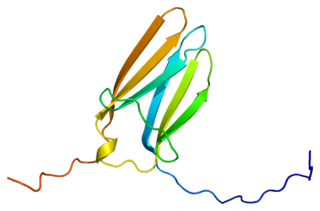
Tropomyosin receptor kinase A (TrkA), also known as high affinity nerve growth factor receptor, neurotrophic tyrosine kinase receptor type 1, or TRK1-transforming tyrosine kinase protein is a protein that in humans is encoded by the NTRK1 gene.

Tropomyosin receptor kinase C (TrkC), also known as NT-3 growth factor receptor, neurotrophic tyrosine kinase receptor type 3, or TrkC tyrosine kinase is a protein that in humans is encoded by the NTRK3 gene.
Trk receptors are a family of tyrosine kinases that regulates synaptic strength and plasticity in the mammalian nervous system. Trk receptors affect neuronal survival and differentiation through several signaling cascades. However, the activation of these receptors also has significant effects on functional properties of neurons.

Proto-oncogene tyrosine-protein kinase ROS is an enzyme that in humans is encoded by the ROS1 gene.
ETV6-NTRK3 gene fusion is the translocation of genetic material between the ETV6 gene located on the short arm of chromosome 12 at position p13.2 and the NTRK3 gene located on the long arm of chromosome 15 at position q25.3 to create the (12;15)(p13;q25) fusion gene, ETV6-NTRK3. This new gene consists of the 5' end of ETV6 fused to the 3' end of NTRK3. ETV6-NTRK3 therefore codes for a chimeric oncoprotein consisting of the helix-loop-helix (HLH) protein dimerization domain of the ETV6 protein fused to the tyrosine kinase domain of the NTRK3 protein. The ETV6 gene codes for the transcription factor protein, ETV6, which suppresses the expression of, and thereby regulates, various genes that in mice are required for normal hematopoiesis as well as the development and maintenance of the vascular network. NTRK3 codes for Tropomyosin receptor kinase C a NT-3 growth factor receptor cell surface protein that when bound to its growth factor ligand, neurotrophin-3, becomes an active tyrosine kinase that phosphorylates tyrosine residues on, and thereby stimulates, signaling proteins that promote the growth, survival, and proliferation of their parent cells. The tyrosine kinase of the ETV6-NTRK3 fusion protein is dysfunctional in that it is continuously active in phosphorylating tyrosine residues on, and thereby continuously stimulating, proteins that promote the growth, survival, and proliferation of their parent cells. In consequence, these cells take on malignant characteristics and are on the pathway of becoming cancerous. Indeed, the ETV6-NTRK3 fusion gene appears to be a critical driver of several types of cancers. It was originally identified in congenital fibrosarcoma and subsequently found in mammary secretory carcinoma, mammary analogue secretory carcinoma of salivary glands, salivary gland–type carcinoma of the thyroid, secretory carcinoma of the skin, congenital fibrosarcoma, congenital mesoblastic nephroma, rare cases of acute myelogenous leukemia, ALK-negative Inflammatory myofibroblastic tumour, cholangiocarcinoma, and radiation-induced papillary thyroid carcinoma.

Crizotinib, sold under the brand name Xalkori among others, is an anti-cancer medication used for the treatment of non-small cell lung carcinoma (NSCLC). It acts as an ALK and ROS1 inhibitor.

ALK inhibitors are anti-cancer drugs that act on tumours with variations of anaplastic lymphoma kinase (ALK) such as an EML4-ALK translocation. They fall under the category of tyrosine kinase inhibitors, which work by inhibiting proteins involved in the abnormal growth of tumour cells. All the current approved ALK inhibitors function by binding to the ATP pocket of the abnormal ALK protein, blocking its access to energy and deactivating it. A majority of ALK-rearranged NSCLC harbour the EML4-ALK fusion, although as of 2020, over 92 fusion partners have been discovered in ALK+ NSCLC. For each fusion partner, there can be several fusion variants depending on the position the two genes were fused at, and this may have implications on the response of the tumour and prognosis of the patient.

Selumetinib (INN), sold under the brand name Koselugo, is a medication for the treatment of children, two years of age and older, with neurofibromatosis type I (NF-1), a genetic disorder of the nervous system causing tumors to grow on nerves. It is taken by mouth.

Binimetinib, sold under the brand name Mektovi, is an anti-cancer medication used to treat various cancers. Binimetinib is a selective inhibitor of MEK, a central kinase in the tumor-promoting MAPK pathway. Inappropriate activation of the pathway has been shown to occur in many cancers. In June 2018 it was approved by the FDA in combination with encorafenib for the treatment of patients with unresectable or metastatic BRAF V600E or V600K mutation-positive melanoma. In October 2023, it was approved by the FDA for treatment of NSCLC with a BRAF V600E mutation in combination with encorafenib. It was developed by Array Biopharma.

Atezolizumab, sold under the brand name Tecentriq, is a monoclonal antibody medication used to treat urothelial carcinoma, non-small cell lung cancer (NSCLC), small cell lung cancer (SCLC), hepatocellular carcinoma and alveolar soft part sarcoma, but discontinued for use in triple-negative breast cancer (TNBC). It is a fully humanized, engineered monoclonal antibody of IgG1 isotype against the protein programmed cell death-ligand 1 (PD-L1).

Entrectinib, sold under the brand name Rozlytrek, is an anti-cancer medication used to treat ROS1-positive non-small cell lung cancer and NTRK fusion-positive solid tumors. It is a selective tyrosine kinase inhibitor (TKI), of the tropomyosin receptor kinases (TRK) A, B and C, C-ros oncogene 1 (ROS1) and anaplastic lymphoma kinase (ALK).

Capmatinib, sold under the brand name Tabrecta, is an anticancer medication used for the treatment of metastatic non-small cell lung cancer whose tumors have a mutation that leads to the exon 14 skipping of the MET gene, which codes for the membrane receptor HGFR.
Tissue-agnosticcancer drugs are antineoplastic drugs that treat cancers based on the mutations that they display, instead of the tissue type in which they appear. Tissue-agnostic drugs that have been approved for medical use include Pembrolizumab, Larotrectinib, Selpercatinib, Entrectinib, and Pralsetinib.

Sotorasib, sold under the brand names Lumakras and Lumykras, is an anti-cancer medication used to treat non-small-cell lung cancer. It targets a specific mutation, G12C, in the protein K-Ras encoded by gene KRAS which is responsible for various forms of cancer. Sotorasib is an inhibitor of the RAS GTPase family.

Avapritinib, sold under the brand name Ayvakit among others, is a medication used for the treatment of advanced systemic mastocytosis and for the treatment of tumors due to one specific rare mutation: it is specifically intended for adults with unresectable or metastatic gastrointestinal stromal tumor (GIST) that harbor a platelet-derived growth factor receptor alpha (PDGFRA) exon 18 mutation. Avapritinib is a kinase inhibitor.

Selpercatinib, sold under the brand name Retevmo among others, is a medication for the treatment of cancers in people whose tumors have an alteration in a specific gene. It is taken by mouth.
Pralsetinib, sold under the brand name Gavreto, is a medication approved for RET mutation-positive medullary thyroid cancer (MTC) and RET fusion-positive differentiated thyroid cancer (DTC) refractory to radioactive iodine (RAI) therapy. Pralsetinib is a tyrosine kinase inhibitor. It is taken by mouth.
RET inhibitors are targeted therapies that act on tumors with activating alterations in the RET proto-oncogene, such as point mutations or fusions. They fall under the category of the tyrosine kinase inhibitors, which work by inhibiting proteins involved in the abnormal growth of cancer cells. Existing molecules fall in two main categories: the older multikinase inhibitors and the more recent selective inhibitors. Although RET alterations are found at low frequency in a broad range of tumors, the three main indications for RET inhibitors today are non-small cell lung cancer, medullary thyroid cancer and papillary thyroid cancer. As of 2020, up to 48 fusion partners have been catalogued in NSCLC rearrangements, with KIF5B and CCDC6 being the most prevalent. At least 10 different fusion variants have been described for KIF5B-RET, each with different breakpoints within the partner gene, but unclear clinical impact as of 2018.
Lipofibromatosis-like neural tumor (LPF-NT) is an extremely rare soft tissue tumor first described by Agaram et al in 2016. As of mid-2021, at least 39 cases of LPF-NT have been reported in the literature. LPF-NT tumors have several features that resemble lipofibromatosis (LPF) tumors, malignant peripheral nerve sheath tumors, spindle cell sarcomas, low-grade neural tumors, peripheral nerve sheath tumors, and other less clearly defined tumors; Prior to the Agaram at al report, LPF-NTs were likely diagnosed as variants or atypical forms of these tumors. The analyses of Agaram at al and subsequent studies uncovered critical differences between LPF-NT and the other tumor forms which suggest that it is a distinct tumor entity differing not only from lipofibromatosis but also the other tumor forms.

Repotrectinib, sold under the brand name Augtyro, is an anti-cancer medication used for the treatment of non-small cell lung cancer. It is taken by mouth. Repotrectinib is an inhibitor of proto-oncogene tyrosine-protein kinase ROS1 (ROS1) and of the tropomyosin receptor tyrosine kinases (TRKs) TRKA, TRKB, and TRKC.














